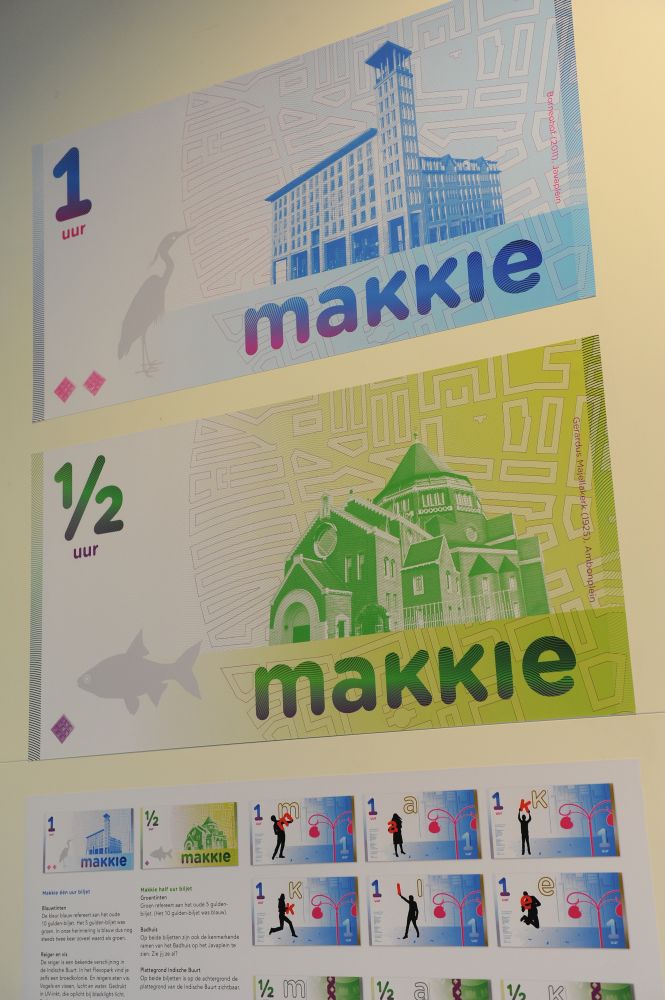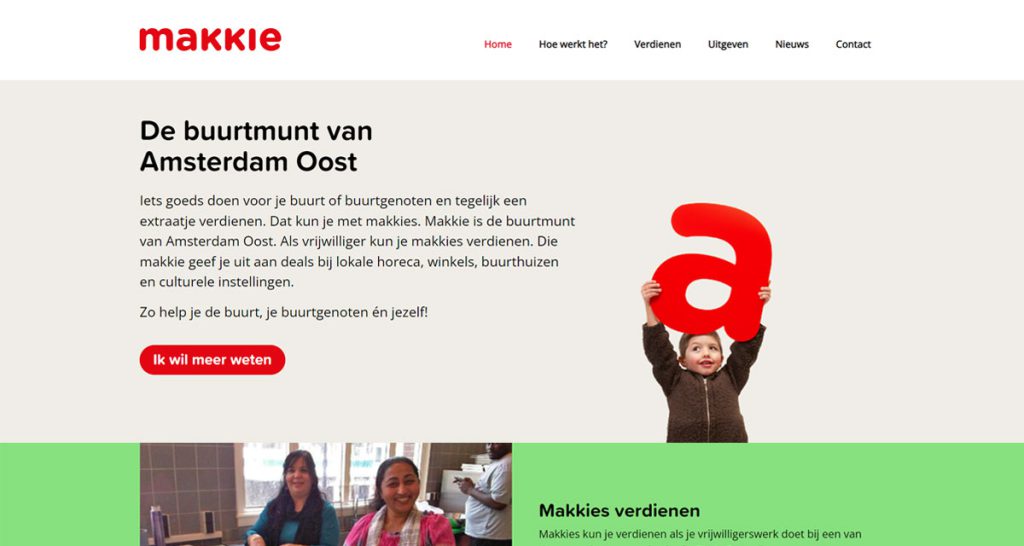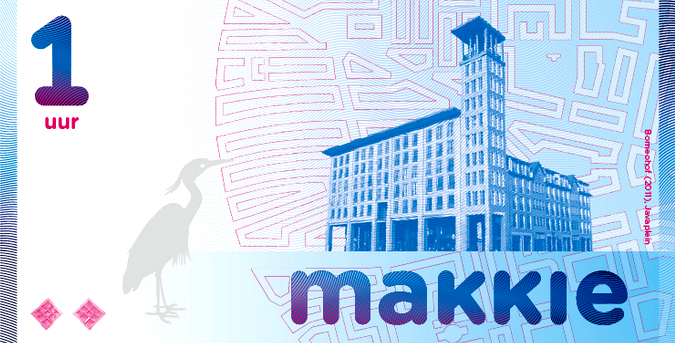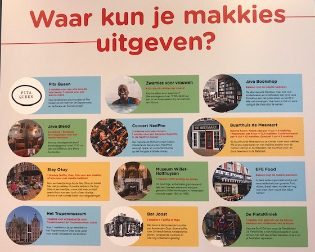In the previous blogs, our colleague Diane Golenvaux explored how strategies to keep money circulating locally can contribute to Community Wealth Building. Time-banks are complementary currencies that are also bound to a local community and come in the form of time-measuring vouchers. In this blog, Diane delves into time-banking and the ways in which it unsettles our understanding of money, value and work. To illustrate this point, she discusses her research on the Makkie, a time-bank network that has been established in Amsterdam Oost since 2012.
Introducing the Makkie and Amsterdam Oost
In the last couple of months, I have been going around Amsterdam Oost to interview local shop owners, community organizers and volunteers who use the Makkie. I also had the opportunity to interview the organizers of the network. From what they told me, it all started with a group of inhabitants from around the Makassarplein, a central square in the neighborhood, surrounded by residential buildings.
They wanted to create more social cohesion in their neighborhood, one neighbor tells me. ‘Then they came up with the idea of a currency, because that would allow them to help each other. Back then there were no shops or other businesses and the municipality was not very present. A local currency would enable them to work from person to person.’ And so the Makkie coin was born.
Today, the Makkie network consists of more than 800 volunteers, 35 local shops and 50 volunteering organizations; the organizers estimate that 2.000 to 3.000 people are involved in the Makkie on a weekly basis. Next to that, the municipality is now funding the project.
The Makkie is a time-bank that is used to remunerate volunteer work and can be spent in some shops of Amsterdam Oost. One Makkie is worth one hour of volunteer work, and there is no direct correlation between the Makkie and the Euro; so each local shop decides with the Makkie team how much the volunteers can purchase with their Makkies. In the beginning of the project, the local shop owners accepted Makkies out of solidarity with the volunteers; but since the municipality is funding the project, they can give the Makkies back to the organizers and get reimbursed up to 90% of the worth of the goods and services that they offered. The five main goals of the project are: to foster greater participation and social cohesion, to support the local economy, emancipation, to close the gap between the unemployed and the job market, and poverty relief.

Most of the places that accept Makkies or give them away are to be found close by, in the surrounding neighborhoods like the Dapperbuurt and Indische Buurt. ‘There is a saying: if you want to find something, you always find it on the Javastraat’, said the manager of the community center De Meevaart, pointing to the dynamic economic life of the area. The neighborhood has been home to various immigrant communities since the 1960s, which are core to the diversity of businesses in the area: from Turkish to Indian grocery shops, Surinamese and Indonesian restaurants.
Dynamic as life might seem here, many residents shared with me that a lot of inhabitants rely on social benefits and solidarity initiatives such as the Makkie. As the bicycle mechanic of Nieuwland, a socio-political center run by the squatting movement, pointed out: ‘this neighborhood is quite poor, but Amsterdam is very rich somehow, you know? And there is a lot of gentrification’. Regulars of a local bar agreed, telling me about the struggle of unemployment and the effects of the housing crisis on the inhabitants.
Since the coronavirus pandemic, Makkie organizers recorded a 50% growth of spending on primary goods such as groceries; which shows that the network is indeed enabling people to make it to the end of the month. As one of them told me: ‘the cost of living crisis forces people to cut back on basic things like swimming lessons or hairdressers, but even then they need to fall back on the local currency to survive’.
The value of one Makkie: valuing volunteer work and setting prices
Whereas the other currency networks that I did research on in Amsterdam had a direct correlation with Euros and did not have alternative mechanisms to set prices, the Makkie does things differently. This local system is challenging the ways in which we let the market determine what something is worth.
Organizations within the Makkie network remunerate their volunteers with Makkies. But the Makkie organizers leave it up to these organizations to determine the details of the job. As long as the work ‘contributes to the neighborhood and social cohesion’, they are free to use Makkies. The volunteer jobs range from bar shifts at the social center, cooking in one of the many community kitchens in this side of town, teaching language classes, organizing activities for the elderly, giving creative workshops or swimming lessons.
Every volunteer is remunerated one Makkie for each hour of work, which creates an equal playing field. Or as one of the organizers pointed out: ‘everyone’s time is worth the same, no matter what you do’. When an organization joins the network, the Makkie team assesses whether they contribute to the neighborhood and what kind of volunteer work could be done before providing the organization with Makkies to remunerate volunteers.
This approach of everyone’s time being worth the same challenges the differentiation that is made on the regular job market, where workers are remunerated in function of the exchange-value of their products on the market, which creates economic inequality and competition based on their marketable skills and overall productivity. However, as one local shop owner pointed out, the Makkies represent ‘just a symbolic wage, because it’s not a lot of money’.
This was echoed by many participants and organizers. Many do not consider the Makkie to be a wage, but more something extra and a way to say thank you. And it is important to note that there is a ceiling on how much Makkies one can earn per month, which lies at 32 Makkies. This is explained through the logic of the welfare institutions, who don’t allow recipients of social benefits to earn money on top of their welfare payments. Most of the participants are on social benefits or in retirement.
Whereas the network cannot sustain the volunteers on its own and its economic impact is limited, it does remunerate labor that is typically done for free and encourages people to contribute to the neighborhood. As such, the Makkie challenges the devaluation of care work and community services in the regular economy. This kind of unpaid work has historically been done by women, and it is no wonder that most of the Makkie volunteers are women as well.
Next to that, the Makkie has no ‘fixed-value’, which means that it is not directly correlated to the Euro. The goods and services that the volunteers can then spend their Makkies on are provided by local businesses, restaurants and cafés or cultural institutions. When these organizations join the network, they discuss with the team how to price their goods and services in Makkies.
From my fieldwork, I gathered that most shops consider one Makkie to be worth around two to two and a half Euros. The organizers confirmed to me that when it comes to grocery stores, this correlation stands. However, they highlighted that in some places, you can get a coffee for only half a Makkie, or a whole meal for two Makkies; and that especially cultural institutions offer interesting deals, such as three Makkies to see an orchestra concert.

The Makkie team tries to get good deals for their volunteers, but they feel that as the network grows and becomes more institutionalized, it is getting more difficult: ‘I have the feeling that people are seeing the Makkie more and more as just one more currency’. Demand for certain goods or services among the volunteers is also taken into account when making contracts with local businesses. When entering the information point, you can see post-its on the wall under the question ‘What would you like to get with your Makkies?’.
The bookstore employee praised the diversity of goods and services available for the volunteers, acknowledging that ‘not everybody wants to buy a book’. There has been an increase in spending on groceries, but the network also allows certain participants to get access to more ‘luxurious stuff’ that they wouldn’t buy otherwise. Many users of the Makkie stated that their extra income in Makkies allowed them to go to a bookstore, a place they wouldn’t normally visit, or to the hairdresser, something they otherwise couldn’t afford.
The organizers told me that their way of working pushes them to constantly reflect on value and engage with it in a critical way. ‘Since there’s not a fixed value, it’s really about what we think is valuable work and what is an appropriate price for these goods.’ This difference between the monetary value determined by the market and what is socially valuable is encapsulated by the ‘exchange-value’ as opposed to the ‘use-value’ in Marxist theory. One of the critiques of market and financialized economic governance is that labor, production and consumption are organized around capital accumulation which creates mismatches between what is socially useful and what is produced and valued in our economy (Hickel, 2021).
Indeed, these community services are useful to the neighborhood and there are people who have the skills and like doing them; but this labor is not valued in our economy. People are not unemployed because they have nothing to contribute to society, but because of the job market failures.
When making contracts with volunteering organizations and local businesses, the Makkie team takes into consideration what is meaningful labor for the social cohesion and wellbeing of the neighborhood; what kind of goods and services are useful to the volunteers; what kinds of consumption and businesses they want to support; as well as what prices are fair to the businesses and their customers. This entails a time-consuming process that comes with face-to-face encounters and bureaucratic work, which is not appreciated by all the members of the network. But it ensures that the currency network is not ruled by market-determined value and that it stays embedded within the community.

Community building, solidarity and gender emancipation
When I came up to local shop owners, employees and volunteers to ask them questions, they were enthusiastic to talk with me and share their experience. They felt engaged in the project and all affirmed that it contributed to the neighborhood socio-economic life. As the volunteers are mostly inhabitants who are living on social benefits, in retirement, or women who are not full time employed, the Makkie helps people to create a social network and integrate better in the neighborhood. This is also the case for some local shop owners, who told me that they joined the network to be better connected to the neighborhood.
The Makkie is building a caring community for people that are socially isolated, said one of the organizers. ‘We heard from an organization that is helping women mainly with language classes, legal advice or digital skills, that sometimes they check up on people that they haven’t seen for some time. Then one lady was really sick and she hadn’t eaten for five days because she couldn’t get out of the house anymore.’ Indeed, because the volunteering organizations work closely with the volunteers and inhabitants, they get a better picture of their struggles than welfare institutions do.
I also have been told that the network embeds solidarity and generosity in the participants’ economic life. This anecdote particularly stuck with me: ‘I had a really nice conversation with our local bicycle store owner, and he mentioned that sometimes there’s a group of women coming in, and they’re buying one bike together. They all save Makkies, and some of them don’t need them that much, and then they’re like putting them in a pile so that one of the women can actually buy a bike for her kid that is going to high school.’
The Makkie team shared with me that there was also a gender emancipation impact that was unintended. Although there was an increase in men’s participation as the network grew, most of the volunteers are women, which also stands for the organizing team. We laughed it off as one of the organizers said she volunteered once with a man: ‘A man?! Wow. But most of them, yeah it’s a women thing’. Through participating in the Makkie, the volunteers learn new skills, gain more financial and social autonomy and confidence. They feel as valuable members of the community and have a socio-economic life of their own, outside the household.
Unmasking money
I tried to uncover how the inhabitants and participants understand the Makkie; if they conceive of it as money or how it differs from the Euro. I received mixed responses, ranging from thinking of it as mutual aid or gift economy currency, to something for poverty relief or another municipality initiative. What is striking, is that as the currency network up-scaled, got involved with the local government and with the regular economy through the reimbursement mechanism, some businesses and users started understanding it more as just another currency. However, for the organizers and the people who have been involved more actively and for longer, there is a consciousness that it is ‘completely different from money’ and an intention for it to not be used just as Euros. ‘It’s the Makkie economy!’
As you can read in any economic handbook, classic theories establish three functions of money: that of a means of exchange, which enables multilateral and impersonal economic exchanges; that of a store of value, which retains at least parts of its value over time and takes the form of savings and capital; and that of a unit of account, which sets a common standard for measuring the worth of goods, services, and debt (Smithin 2000). Different arguments have been made about the historical development of money. Some understand money as arising from markets to facilitate efficiently impersonal large-scale exchanges (Menger, 1892), others from states and tax obligations (Mitchell-Innes 1914; Wray 2003), and others from financial institutions and debt systems (Graeber 2011).

However, complementary currencies such as the Makkie challenge these functions and narratives about money: What about currencies that are not created to facilitate impersonal or large-scale exchanges? What about currencies that are not designed to be accumulated or invested? What about currencies that do not have a fixed value determined by markets or institutions? What about currencies that are not issued and legitimized by the state for taxation or by banks to denominate debt?
The development of official currencies as embodying these three functions simultaneously and being issued by central banks but credited and speculated on through private banking, is a specific institutional arrangement that is not inevitable. As the story of the Makkie highlights, money is a social construct which exists in virtue of social collaboration and trust (Ingham, 2004). In our economy, money shapes our social and economic relations, our understanding of value and work, as well as our access to and mobilization of resources. Monetary governance can be shaped for other purposes than that of capital accumulation: it can go against market-determined value, against competitive exchange relations, against the devaluation of care work and against unemployment. The Makkie is a good example of this.
Further discussion points
Some further interesting insights from my fieldwork are:
- The network has a sometimes contentious relationship with the municipality. The Makkie is funded by the Werk & Participatie program from the municipality which has allowed for the project to sustain itself over time and to grow, but limits the organizers in pursuing a community-based approach. How can organizations keep their grassroots commitment while collaborating with the local government? How can complementary currency networks be autonomous from a funding perspective?
- As the local shop owners can get reimbursed in Euros, and most of them do so instead of spending their Makkies in other local shops, the circularity of the network is limited. The administration is also complicated by the fact that the process of the organizations getting Makkies to reward volunteers is separate from them receiving Makkies from customers. How could the network encourage businesses to spend (at least parts of) their Makkies back in the local economy? How could the administration of distributing the Makkies and collecting them be simplified?
- The municipality and organizers are discussing the possibility of digitizing the network, partly as a solution to the previous points. This would simplify the administrative processes and reduce the costs, which could enhance the circularity and independence of the network. However, this could result in losing some of the Makkie users which are not all trusting of or skilled with digital platforms, as well as in loosening the community ties by reducing personal interactions. How could the digitalization of the network simplify the network’s administration while still enhancing the community?
The relationship to the local government, the circularity issue and the digitalization of the time-bank network will be discussed more extensively in Diane’s research. Stay tuned if you want to read more on these issues, as the findings will be published in the fall!
Bibliography
Graeber, David. 2011. Debt: The first 5,000 years. New-York: Melville House. ISBN 978-
1612191294.
Ingham, Goeffrey. 2004. The Nature of Money. Cambridge: John Wiley & Sons.
Lietaer, Bernard & Dunne, Jacqui. 2013. Rethinking Money: How New Currencies Turn Scarcity into Prosperity. Bernett-Koehler Publishers, Inc.
Menger, Karl. 1892. On the origin of money. The Economic Journal, 2(6), 239–255.
Mitchell Innes, Alfred (1914). The Credit Theory of Money. The Banking Law Journal 31, 151-168.
Smithin, John. 2000. What Is Money? London: Routledge.
Wray, Randall L. 2003. Understanding Modern Money: The Key to Full Employment and Price Stability. Cheltenham: Elgar.

 ☰
☰